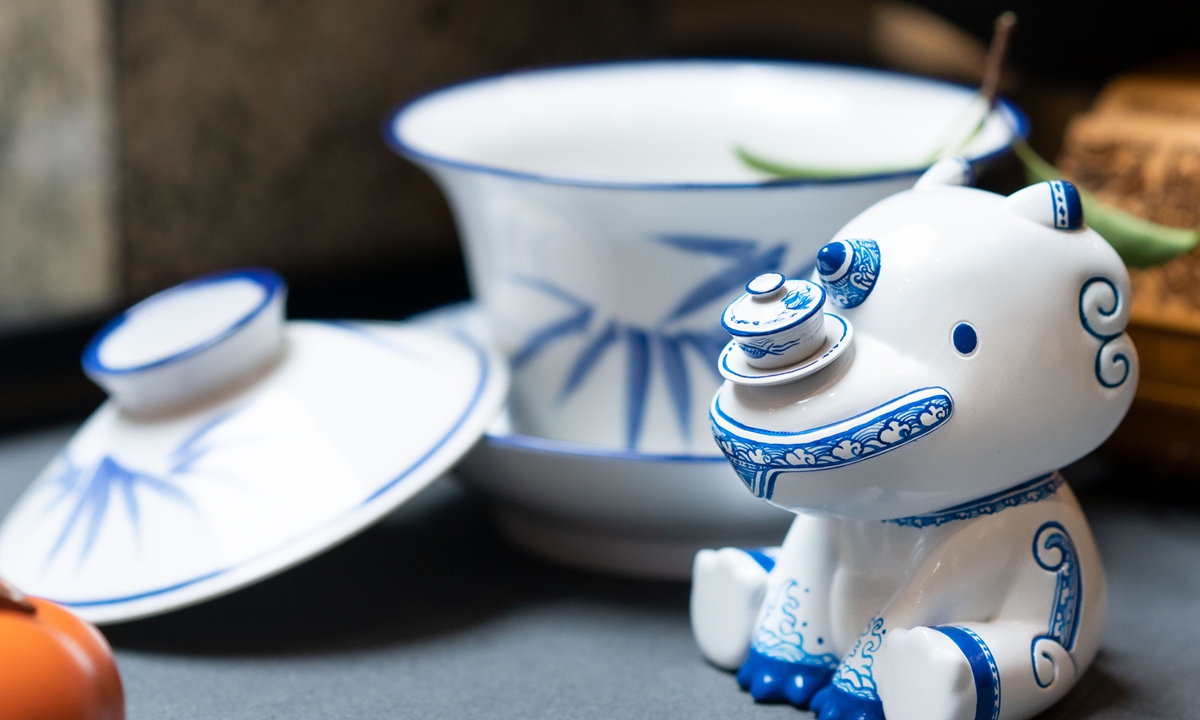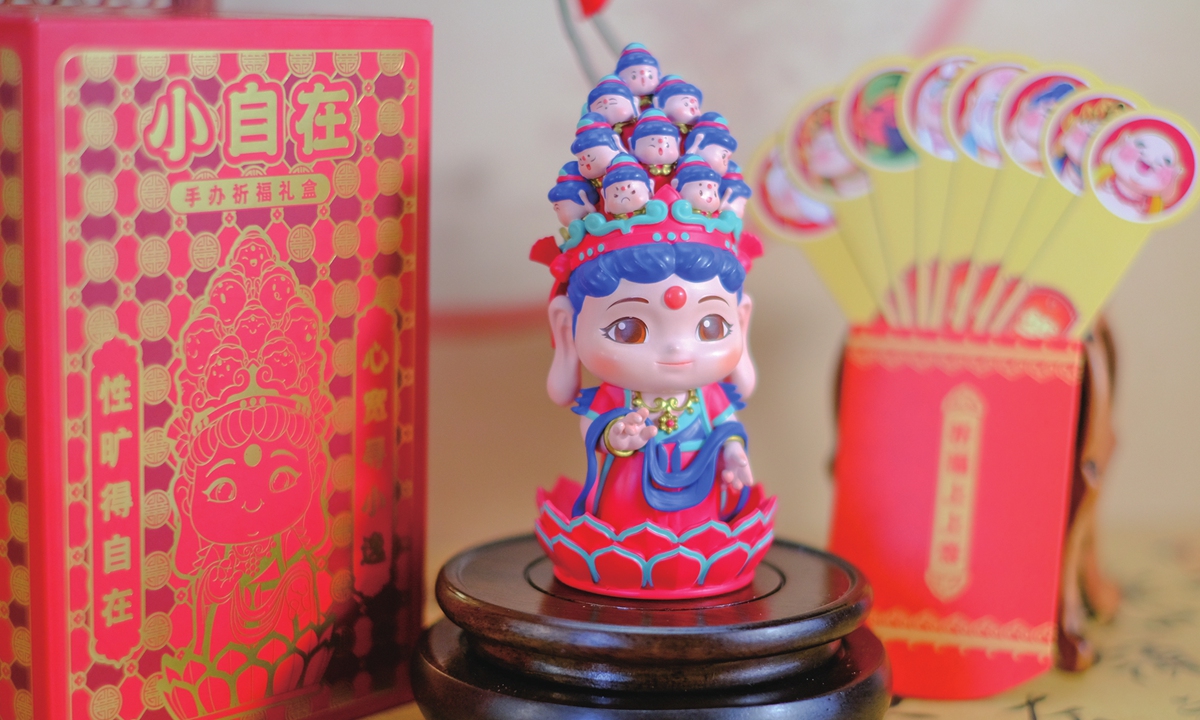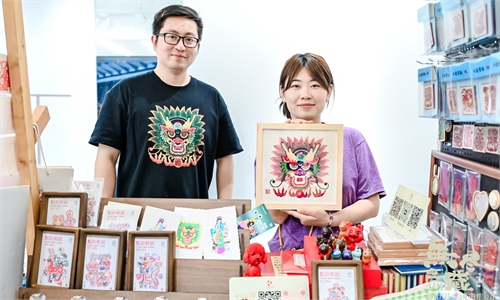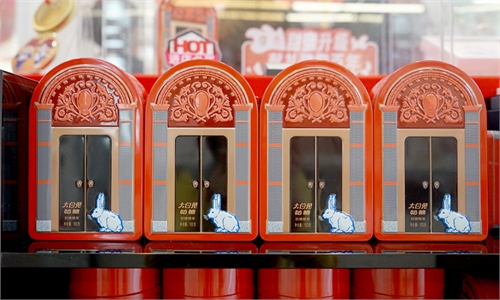ARTS / CULTURE & LEISURE
Cultural planners turn ancient art into modern symbols
Behind creations

Blind boxes with traditional Chinese elements designed by Zeng Zhou Photo: Courtesy of Zeng Zhou
Deep inside the 65-year-old Chengdu Museum stands its iconic treasure: An 8.5-ton stone rhinoceros. While in the museum's cultural and creative product section, its miniature versions — designed as various box collectibles — have become top-selling souvenirs.
Inside each blind box, visitors might discover a rhino adorned with blue-and-white porcelain patterns, a spicy hotpot-themed version, or one featuring the hibiscus flower, the official flower of Chengdu, capital of Southwest China's Sichuan Province. These wildly popular products were created by Zeng Zhou, a cultural creative product designer and planning operator born in the 1990s.
A similar cultural scene is unfolding in North China's Tianjin. At a recent cultural fair in the northern municipality, over 1,000 souvenir boxes sold out on launch day.
Each contained "Xiao Zizai," a figurine inspired by the 11-faced Guanyin (Chinese goddess of mercy) clay sculpture from the Dule Temple in Jizhou district. The figurine was designed by Wu Di, a planner and operator of cultural products at the ancient temple.
These museum-inspired creations have become increasingly popular, bringing cultural creative product planners into the public eye. In 2024, China's Ministry of Human Resources and Social Security officially added the profession to its list of new occupations.
Once considered a niche interest, cultural creative products are now a heated consumer demand, fueled by a growing passion for traditional culture, the rise of Guochao (China-chic), and an overall upgrade in consumption habits. According to China's state broadcaster, China Central Television,many museums and design firms are eager to recruit cultural creative product designers who not only understand design, but also excel in marketing and operations.
According to National Bureau of Statistics, China's cultural industry achieved an operating revenue of 19.1423 trillion yuan ($2.67 trillion) in 2024, setting a new record high and marking a year-on-year increase of 7.1 percent.
"Traditional Chinese culture is an inexhaustible treasure. Through cultural products, the solemn side of traditional culture can be presented in a playful and engaging way," Zeng told the Global Times.
Bringing history to fingertips
Zeng's journey into cultural design began in 2019, when a visit to the Sanxingdui Museum in Chengdu sparked a wave of inspiration. Captivated by the ancient bronze figures on display, he imagined a seated, stylized version of the standing bronze figure, with exaggerated protruding eyes and large ears, which is both humorous and strikingly modern.
"Creative design allows for exaggeration, but it must still align with the features of the original artifact," he said.
Using museum products, traditional cultural IPs, and Sichuan characteristics as a creative inspiration, Zeng and his team continuously develop new products.
To Zeng, the goal of creative design isn't just to make trendy products.
"We're building cultural IPs — objects with content and emotional depth. Our hope is that the younger generations can easily access and feel the presence of millennia-old traditions. That might take one generation, or even several," he told the Global Times.
In Zeng's view, cultural and creative products can turn what were once lifeless products into companions that "speak" to you and convey emotion — and even become sources of pride when being shared on social media.
"The success of brands like Labubu has already shown us: Those who create truly unique and soulful products that foster emotional connection and identity will win the hearts of numerous consumers and the future of the market," said Zeng.

Xiao Zizai, a souvenir figurine inspired by the 11-faced Guanyin (Chinese goddess of mercy) clay sculpture at the Dule Temple Photo: Courtesy of Wu Di
'Cultural vessel'
As one of the three remaining Liao Dynasty (916-1125) temples in China, the Dule Temple also serves as one of the filming locations for the Chinese hit video game Black Myth: Wukong.
The 11 faces of the Guanyin statue symbolize a spectrum of emotional and philosophical meanings. While staying true to its traditional sculptural art and regional cultural heritage, each expression is reinterpreted as an emotional symbol that resonates with modern life. This transforms the piece from a mere decorative item into a "cultural vessel" that carries personal sentiment and emotional connection, Wu Di told the Global Times.
Wu, the cultural creative product planner and operator at the Dule Temple, somehow echoed Zeng's notion in design, saying the core mission of cultural and creative product planning is to breathe new vitality into the cultural genes of ancient landscapes in the everyday lives of contemporary people.
He normally begins his routine work day by sketching the sculptures and murals of the temple. Based on his experiences, key elements in creating hit cultural and creative products include thorough research and understanding of traditional culture to ensure design authenticity, coupled with insights into contemporary consumer preferences.
Equally important are addressing users' emotional needs from multiple dimensions and encouraging them to share how these products interact with their daily lives on social media.
For example, he uses short videos to document the entire journey of a product, allowing users to see how a design idea evolves into a real cultural item. "This process of 'demystification' actually makes traditional culture more approachable and sparks greater public interest in it," he said.
In response to criticism that some cultural and creative products may overly "entertain" elements of historical landmarks, Wu said that cultural communication requires a layered strategy.
"For professional and academic audiences, we maintain seriousness through artifact replicas, scholarly content and curated exhibitions. For the general public, our approach emphasizes the gradual power of culture to inspire. A user might be drawn to a cultural product at first glance, which then sparks interest in the related site or relic — and eventually leads to deeper engagement with the underlying heritage. This, in itself, is a healthy cycle of cultural dissemination," he added.



